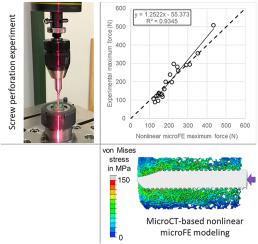Journal of the Mechanical Behavior of Biomedical Materials ( IF 3.3 ) Pub Date : 2021-01-22 , DOI: 10.1016/j.jmbbm.2021.104344 Vasiliki C. Panagiotopoulou , Marzieh Ovesy , Boyko Gueorguiev , R. Geoff Richards , Philippe Zysset , Peter Varga

|
Surgical treatment of proximal humerus fractures remains challenging, with a reported failure rate ranging from 15% to 35%. The dominant failure mode is secondary, i.e. post-operative screw perforation through the glenohumeral joint. A better understanding and the ability to predict this complication could lead to improved fracture fixation and decreased failure rate. The aims of this study were (1) to develop an experimental model for single screw perforation in the human humeral head and (2) to evaluate the ability of densitometric measures and micro finite element (microFE) analyses to predict the experimental failure event.
Screw perforation was investigated experimentally in twenty cuboidal specimens cut from four pairs of fresh-frozen human cadaveric proximal humeral heads. A centrally inserted 3.5 mm screw was pushed quasi-statically at a constant displacement rate until perforation of the articular cartilage in each specimen. Force and displacement were recorded and evaluated at both initial screw loosening and perforation events. Bone volume was calculated around and in front of the screw and tip-to-joint distance was measured on the combined pre- and post-instrumentation micro computed tomography (microCT) scans. Implicit linear and explicit non-linear microFE models were created based on the microCT scans. The strength of these densitometric, geometrical and microFE methods to predict the experimental results was evaluated via correlation analysis. The bone volume measures were optimized in a parametric analysis to maximize correlation coefficients.
The strongest and quantitatively correct predictions of perforation force (R2 = 0.93) and displacement (R2 = 0.77) were achieved using the explicit, non-linear microFE models. Linear microFE simulations provided the strongest predictions of loosening force (R2 = 0.90). Correlation strengths reached by optimized bone volume measures for predicting experimental force and by tip-to-joint distance for predicting displacement were only slightly inferior compared to the results of microFE models.
The strong correlations achieved with densitometric and geometric measures indicate that monotonic perforation of single screws through the articular surface of the humeral head can be well predicted with these easily accessible measures. However, non-linear microFE models delivered even stronger correlations and quantitatively correct predictions of perforation force and displacement. This indicates that if computational resources are available, non-linear simulations may have a high potential to investigate more complex fixations and loading scenarios.
中文翻译:

肱骨近端二次螺钉穿孔的实验和数值研究
肱骨近端骨折的手术治疗仍然具有挑战性,据报道失败率在15%至35%之间。主要的失败模式是继发性的,即术后通过肱骨头关节螺钉穿孔。更好的理解和预测这种并发症的能力可导致改善的骨折固定和降低的失败率。这项研究的目的是(1)建立用于人体肱骨头的单螺钉穿孔的实验模型,以及(2)评估光密度测量和微有限元(microFE)分析以预测实验失败事件的能力。
在从四对新鲜冷冻的人尸体肱骨近端头切下的二十个立方体标本中,对螺钉穿孔进行了实验研究。中心插入的3.5 mm螺钉以恒定的位移速率准静态推动,直到每个样本中的关节软骨穿孔为止。在最初的螺丝松动和穿孔事件中记录并评估力和位移。在仪器前后结合微型计算机断层扫描(microCT)扫描,计算出螺钉周围和螺钉前端的骨体积,并测量针尖到关节的距离。基于microCT扫描创建隐式线性和显式非线性microFE模型。通过相关分析评估了这些光密度法,几何学和microFE方法预测实验结果的强度。
使用显式的非线性microFE模型可实现对射孔力(R 2 = 0.93)和位移(R 2 = 0.77)的最强且定量上正确的预测。线性microFE模拟提供了最强的松动力预测(R 2 = 0.90)。与microFE模型的结果相比,通过优化的骨体积测量值来预测实验力以及通过尖端到关节的距离来预测位移所达到的相关强度仅稍逊一筹。
用光密度测量和几何测量获得的强相关性表明,通过这些容易获得的测量方法,可以很好地预测单个螺钉穿过肱骨头的单调穿孔。但是,非线性microFE模型提供了更强的相关性,并定量地预测了射孔力和位移。这表明,如果有计算资源可用,则非线性仿真可能具有研究更复杂的固定装置和加载方案的巨大潜力。









































 京公网安备 11010802027423号
京公网安备 11010802027423号